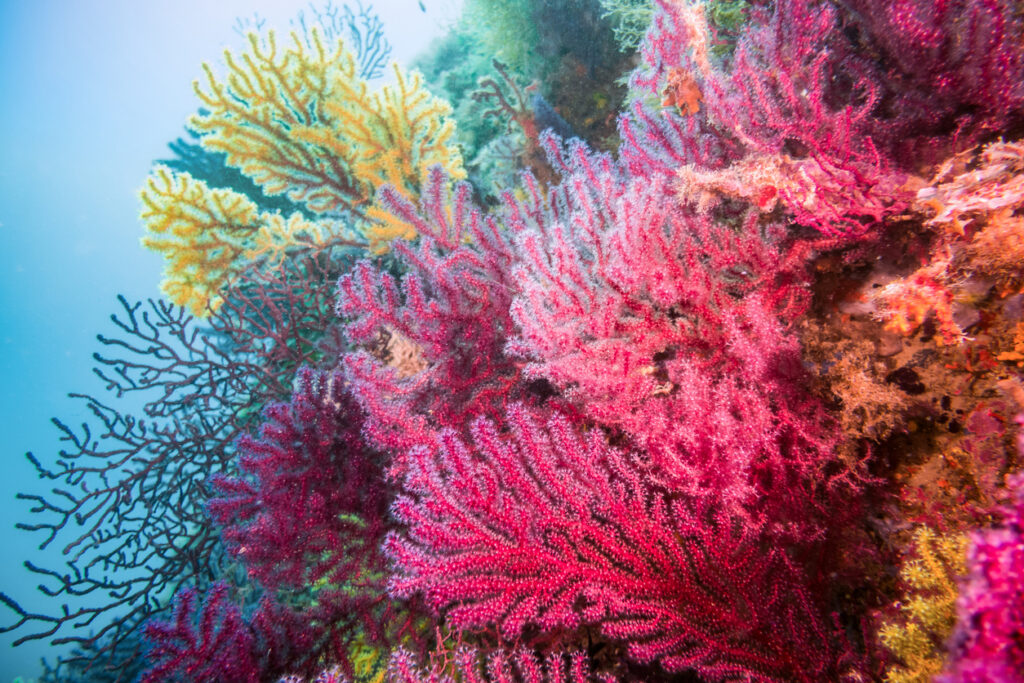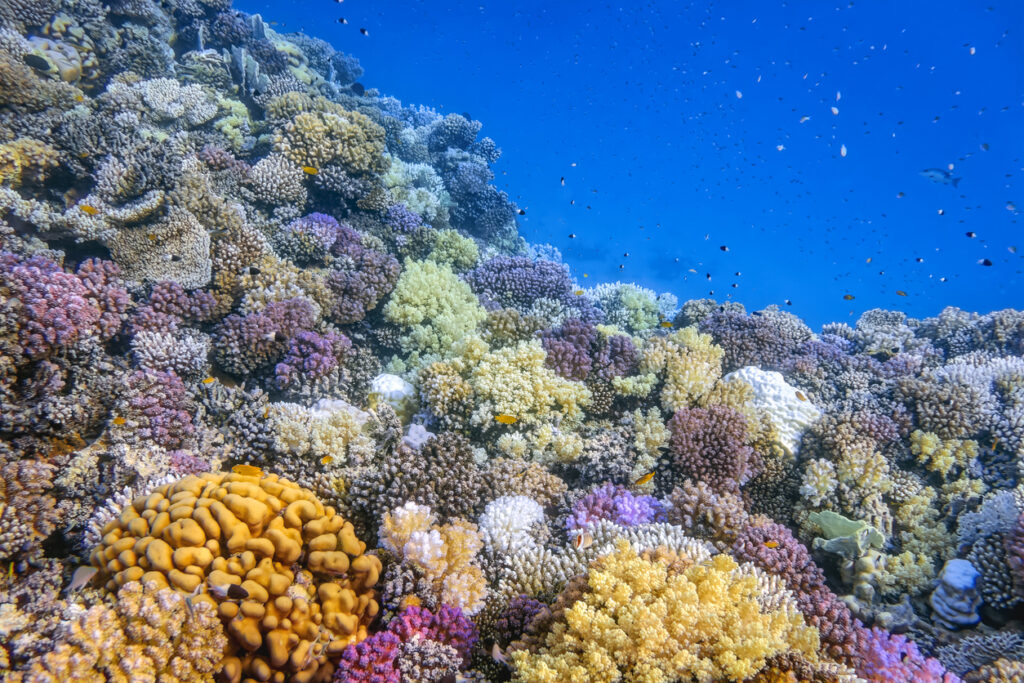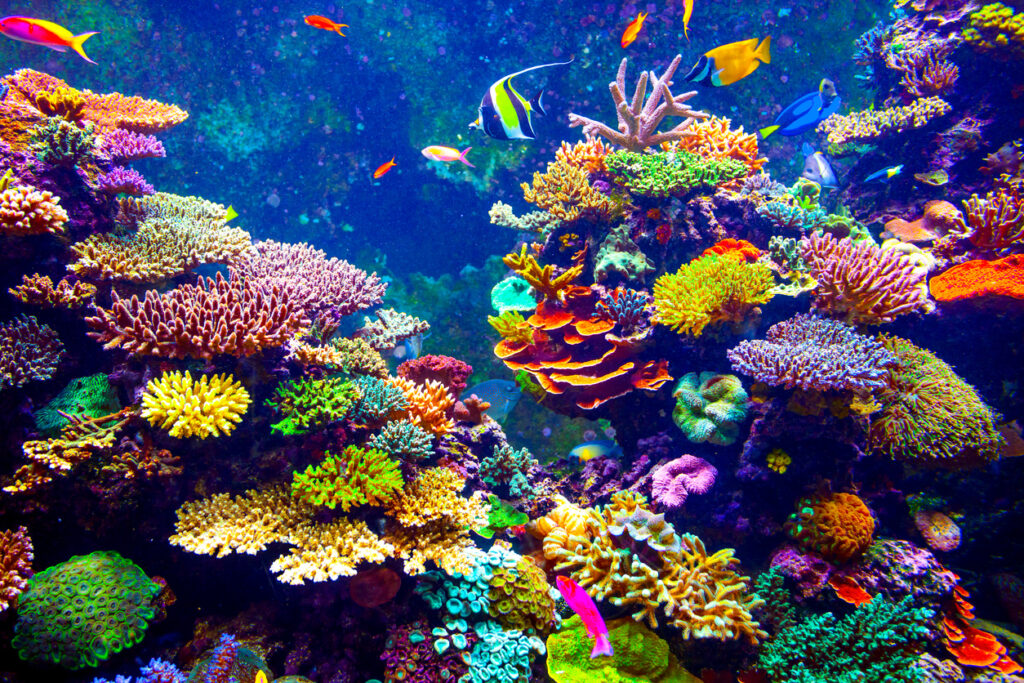Providing an underwater rainbow of colour, coral can be found throughout the world’s oceans. Living in both tropical and cold seas, coral are also found in both shallow and deeper water, making them incredibly diverse. Coral is not only fascinating but also essential to our ecosystems. With that in mind, here are 12 interesting facts about coral that you should know.
Coral are animals
They might look like plants or even rocky outcrops, but coral are in fact animals – something that might not be well known. Coral belong to the phylum Cnidaria, which means they are related to sea anemones and jellyfish. By definition, coral is a marine invertebrate that form colonies of individual polyps.
There are 6,000 species of coral
It’s estimated there are around 6,000 species of coral and they vary hugely in appearance. Some live in warm shallower waters while others prefer life on the dark and cold seafloor.
Some diverse examples of coral include the staghorn coral, which literally resemble deer antlers. Lettuce leaf coral grows in a cone-shape with ruffled edges to resemble lettuce or cabbages. Bubble coral, on the other hand, appear to look like bubbles or bunches of grapes.
Coral are one of the longest-living animals
Some of the oldest known coral lived over 500 million years ago in the Cambrian period. During this time there was something known as the Cambrian Explosion, which saw a huge diversity of lifeforms emerge.
It has been thought that coral can live for up to 5,000 years, although this is likely referring to entire coral reefs. Colonies and individual polyps will typically have shorter lifespans, but could still live for hundreds of years.

Coral grow at an incredibly slow pace
Coral grow around 0.5-2cm per year, and their growth can be impacted by their environment. For instance, large coral reefs grow where strong waves and currents are found. Strong waves allow for more food to be delivered to the ecosystem, which in turn creates the coral structure.
With that slow growth in mind, it could take coral reefs up to a decade to recover after bleaching, which is why it’s so important to look after our coral!
Marine animals need support from coral to survive
Coral colonies are a biodiversity hotspot, with many other species relying on coral for everyday life. Coral can provide important shelter, food and breeding grounds for many different marine animals, giving refuge to animals like turtles, seahorses and crustaceans, as well as a variety of species of fish.
Coral plays a very important role in the survival and protection of our planet
Coral doesn’t just protect marine life, but it can impact the wider protection of our planet. For instance, the formation of coral reefs can protect coastlines from the likes of weather erosion, and they can act as barriers to threats like tsunamis, as they can reduce the wave energy of the water.
Corals can also protect areas like seagrass beds and mangrove forests, both of which are able to absorb carbon dioxide.
Millions of people also depend on coral reefs for things like food and jobs. Coral is incredibly important in contributing to fishing and even tourism.

Hard coral forms coral reefs
Coral reefs are typically built by the polyps known as hard or reef-building corals. They secrete calcium carbonate which provides a place for new coral to settle.
There are 3 different types of coral reefs
The 3 types of coral reefs include barrier reefs, fringing reefs and atoll. Barrier reefs get their names from being able to protect the shallower waters along the shore, offering protection for sea plants and marine life. This type of reef will break down the strong waves so they don’t hit the shore at full force.
Fringing reefs typically grow near the coastline and are separated from the shore by shallow lagoons. These are the most common type of coral reef.
Atolls are rings of coral, designed to create protected lagoons and can be found in the middle of the ocean. Atolls typically form when the islands that are surrounded by fringing reefs sink further into the sea, or the sea level rises.
The Great Barrier Reef can be seen from outer space
Located off the coast of Queensland in Australia, the Great Barrier Reef was created between 5,000-10,000 years ago. It covers a crazy 2,600 miles of ocean floor and crosses 500 islands. Within this huge coral structure, there are a further 900 smaller reefs.
It is the world’s largest single structure created by living organisms, and with that being said, it can actually be seen from space.
Corals have a symbiotic relationship with algae
Coral and algae have a mutually beneficial relationship. The coral provide shelter for the algae, known as zooxanthellae, while it is actually the algae that provides the coral with its bright colours and energy.

Coral need protection from sunlight
The algae that provides coral with its colour and energy need sunlight in order to photosynthesise, but too much sunlight could be damaging. If the ocean becomes too warm, the coral will become stressed and as a result will expel the algae. This results in what we know as coral bleaching, as the coral becomes white in colour.
Climate change is the biggest threat to coral
As mentioned above, a warmer ocean can contribute to corals becoming damaged. Corals will rely on the algae for their nutrition, so once the algae has been dispelled, it can weaken the coral and it may eventually die.
However, it has been shown that this process can be reversed, which is why it’s so important to look after our planet, including our oceans.
How you can help coral thrive
There are many things you can do that can help our world’s coral flourish, and while some of them may seem like small actions, they can quickly become significant.
Reducing your carbon footprint is one of the most important ways to fight the effects of climate change. Take small steps like driving your car less, switching to energy efficient lightbulbs and recycling your waste responsibly.
Tourism can be damaging to coral reefs, so if you’re travelling, be sure to research coral-friendly businesses in the area – particularly the likes of snorkel and diving operators.
Be sure to pick up any rubbish if you’re visiting a coastal area, as it’s more likely to end up in the ocean and damage the ecosystem. Similarly, leave the beach and reef as you found it, and consider sustainable souvenirs or simply just take a photo.
Our world’s coral reefs are incredibly beautiful and vital for the future of our wildlife and ecosystems. You can find out more about our conservation efforts right here at Blue Reef Aquarium Newquay, or buy your tickets and come to see our exhibits to learn more about the importance of aquatic animals and their future.
